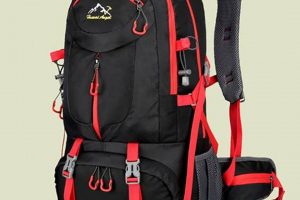The act of securing trekking poles to a rucksack involves utilizing designated attachment points or employing adaptable strapping techniques. This process allows for hands-free mobility when the poles are not needed, such as during scrambles or navigating varied terrain. Proper attachment ensures the poles remain secure and do not interfere with movement or balance. For instance, when encountering a steep incline requiring both hands for stability, one can affix the poles to the pack for convenient storage.
Efficiently stowing the poles offers several advantages. It frees the hands for tasks like map reading, navigating obstacles, or taking photographs. Secure storage also prevents damage to the poles themselves during periods of non-use. Historically, hikers would often carry poles in hand continuously, but modern pack designs now offer integrated systems for more convenient and safer transport. This evolution in gear design enhances overall trekking efficiency and comfort.
This exposition will now detail the common methods for securing trekking poles to a pack, including utilizing external loops, compression straps, and purpose-built attachment systems. Further discussion will cover essential considerations for maintaining pole security and accessibility during various hiking scenarios.
Practical Advice for Pole Attachment
The following recommendations aim to optimize the method of securing poles to a rucksack, enhancing safety and efficiency while on the trail.
Tip 1: Utilize Designated Loops: Many modern backpacks feature dedicated loops and elastic cords designed specifically for trekking pole attachment. These systems typically involve inserting the pole tips downwards through a lower loop and securing the pole shafts with an upper elastic cord or strap.
Tip 2: Employ Compression Straps: If the backpack lacks dedicated loops, compression straps can serve as an alternative. Position the poles vertically along the sides of the pack and secure them tightly using the compression straps. Ensure the poles are evenly distributed to maintain balance.
Tip 3: Secure Pole Tips: Regardless of the chosen method, always ensure the pole tips are pointed downwards or secured to prevent accidental injury or damage to the surrounding environment. Consider using rubber tip protectors for added safety.
Tip 4: Check for Stability: Before embarking on a hike, thoroughly test the stability of the attached poles. Shake the pack vigorously to ensure the poles remain securely fastened and do not shift excessively.
Tip 5: Prioritize Accessibility: Position the poles in a manner that allows for quick and easy access when needed. Avoid burying them deep within the pack or obstructing access to other essential gear.
Tip 6: Adjust for Terrain: The method employed to secure the poles may need adjusting based on terrain type. When scrambling, consider placing the poles inside the pack to prevent damage or snagging. In flatter areas, attachment to the exterior may suffice.
Tip 7: Inspect Regularly: Periodically inspect the attachment points and straps for signs of wear and tear. Damaged or weakened straps should be repaired or replaced to ensure the poles remain securely attached.
Tip 8: Consider Pole Weight and Distribution: Be mindful of the weight of the trekking poles and strive for even distribution when attaching them to the pack. Imbalances can lead to discomfort and fatigue during prolonged hikes.
Adhering to these suggestions enhances the safety, comfort, and efficiency of carrying trekking poles on a backpack.
The following section will discuss common challenges and troubleshooting tips for securing trekking poles.
1. Stability
The connection between stability and the practice of affixing trekking poles to a rucksack is foundational. Stability, in this context, refers to the degree to which the poles remain securely attached and immobile once fastened to the pack. Insufficient stability can lead to various negative consequences. For instance, loosely secured poles may swing erratically, impacting the wearer’s balance and potentially causing injury, particularly on uneven terrain. The repeated shifting can also damage the pack, attachment mechanisms, or the poles themselves. Consider a scenario where a hiker is traversing a narrow mountain path; unstable poles could snag on vegetation or rock outcroppings, creating a tripping hazard or causing the hiker to lose balance. Therefore, achieving a high degree of stability is paramount for safe and efficient hiking.
Several factors contribute to the overall stability of pole attachment. These include the design and quality of the rucksack’s attachment points, the type and condition of the straps or cords used, and the weight distribution of the poles in relation to the pack’s center of gravity. Backpacks with dedicated trekking pole attachment systems often provide superior stability compared to improvised methods. Furthermore, regularly inspecting and maintaining the attachment hardware is crucial. Worn or damaged straps can compromise stability, leading to the aforementioned hazards. Adjusting the straps to achieve a snug fit and ensuring the poles are positioned close to the pack’s center of gravity are key to minimizing movement.
In summary, the pursuit of stability is an indispensable aspect of securing trekking poles to a rucksack. Failing to prioritize stability introduces potential risks to both the hiker and their gear. Adhering to best practices for attachment, regularly inspecting equipment, and adjusting attachment methods based on terrain are essential steps in mitigating these risks. Ultimately, a stable and secure attachment contributes significantly to a safer and more enjoyable hiking experience.
2. Accessibility
Accessibility, in the context of rucksack-affixed trekking poles, denotes the ease and speed with which the poles can be deployed or stowed during a hike. This factor directly influences the user’s efficiency and safety, particularly when traversing varied terrain or encountering unexpected obstacles.
- Quick Deployment in Dynamic Environments
Rapid deployment is essential when transitioning between terrains requiring hand support and those that do not. For example, a hiker descending a steep, rocky slope might need immediate access to poles for stability. A poorly designed attachment system that requires significant time or effort to release the poles negates their benefit in such situations, potentially increasing the risk of falls. Attachment systems should, therefore, prioritize ease of use, even with gloves or in adverse weather.
- One-Handed Operation
Ideally, the attachment system should allow for one-handed operation. This is particularly important when the other hand is occupied with maintaining balance, holding onto a rope, or consulting a map. A system requiring both hands to operate increases the risk of instability and delays the deployment process. Designs that incorporate intuitive release mechanisms, such as quick-release buckles or easily manipulated elastic cords, facilitate one-handed operation.
- Ergonomic Design and Placement
The placement of the attachment points on the rucksack significantly affects accessibility. Attachment points positioned within easy reach, without requiring excessive contortion or removal of the pack, enhance the user experience. Ergonomic designs consider the natural range of motion and ensure that the poles can be accessed and stowed with minimal effort. For example, side-mounted attachment points may offer better accessibility than those located on the back panel, depending on individual flexibility and pack size.
- Minimizing Interference with Other Gear
The attachment system should not impede access to other essential gear within the pack. Poles should be secured in a manner that prevents them from obstructing zippers, pockets, or other critical compartments. A well-designed system integrates seamlessly with the pack’s overall layout, ensuring that the poles are readily accessible without compromising access to other necessary equipment. For instance, external attachment points that run parallel to compression straps, rather than across them, can prevent interference with gear access.
These considerations highlight the intrinsic link between accessibility and secure pole storage. An attachment system that prioritizes quick, one-handed operation, ergonomic design, and minimal interference with other gear contributes significantly to a hiker’s overall safety, efficiency, and comfort. Failure to address these aspects can diminish the utility of the trekking poles and potentially increase the risks associated with hiking in challenging environments.
3. Protection
The concept of protection, when considered in conjunction with affixing trekking poles to a rucksack, encompasses safeguarding both the poles themselves and the hiker’s surrounding environment. Improper attachment techniques can lead to damage to the poles, posing risks of breakage and rendering them ineffective for their intended purpose. Similarly, unsecured pole tips can pose a hazard to other hikers, particularly on crowded trails, or cause unintended damage to fragile ecosystems. Therefore, protective measures constitute a critical aspect of any method used for affixing trekking poles.
Effective pole attachment incorporates several protective strategies. Covering pole tips with rubber protectors mitigates the risk of accidental injury to others and prevents damage to sensitive terrain, such as alpine meadows. Securely fastening the poles to the pack prevents them from swinging freely, thereby reducing the likelihood of impact damage against rocks, trees, or other obstacles. Employing padded attachment points minimizes abrasion and wear on the poles’ shafts. Furthermore, some backpacks feature dedicated compartments or sleeves designed to fully encase the poles, offering maximum protection during transport. For instance, specialized mountaineering packs often include reinforced external attachment points specifically intended to withstand the rigors of ice axe and trekking pole carry.
In summary, the protection component of affixing trekking poles to a rucksack is not merely an ancillary consideration, but rather an integral element of responsible hiking practices. By prioritizing protective measures during attachment, hikers minimize the risk of equipment damage, prevent potential harm to others, and reduce their environmental impact. The selection of appropriate attachment methods and the utilization of protective accessories contribute significantly to a safer and more sustainable hiking experience.
4. Balance
Maintaining equilibrium during hiking necessitates careful consideration of weight distribution, particularly when trekking poles are affixed to the rucksack. An imbalanced load can induce postural instability, increase energy expenditure, and elevate the risk of falls, negating the benefits of hands-free carrying. Proper pole attachment is, therefore, integral to preserving a hiker’s center of gravity and overall stability.
- Lateral Weight Distribution
Uneven weight distribution from side to side can cause a hiker to lean, leading to muscle strain and impaired balance. When affixing poles, ensure they are positioned symmetrically on the rucksack. If one pole is heavier than the other, or if additional gear is attached to one side of the pack, counterbalance measures are necessary. For example, distributing water bottles or other heavy items on the opposite side can mitigate the imbalance. The goal is to achieve a laterally balanced load, minimizing any tendency for the hiker to tilt to one side.
- Vertical Center of Gravity
The height at which the poles are positioned on the rucksack affects the hiker’s center of gravity. Attaching poles too high can raise the center of gravity, making the hiker more susceptible to instability, especially on uneven terrain or during windy conditions. Conversely, positioning the poles too low can hinder mobility and potentially cause them to snag on obstacles. The optimal placement positions the poles relatively close to the hiker’s back and at a height that does not significantly alter the natural center of gravity. This placement promotes stability and allows for a more natural gait.
- Dynamic Load Shift Mitigation
As a hiker moves, the weight distribution within the rucksack can shift dynamically, further impacting balance. Securely fastening the poles to the pack minimizes this dynamic load shift. Loose or poorly secured poles can swing or bounce, creating disruptive forces that challenge the hiker’s equilibrium. Tightening attachment straps and utilizing compression features on the rucksack restricts movement and maintains a more stable load. For instance, using internal compression straps within the pack can further secure the poles and prevent them from shifting during vigorous activity.
- Impact on Posture and Gait
An unbalanced rucksack can induce compensatory adjustments in posture and gait, potentially leading to discomfort and injury over prolonged hikes. When poles are unevenly distributed, the hiker may unconsciously lean or twist to compensate, placing undue stress on specific muscle groups and joints. Correct pole attachment, promoting balanced weight distribution, allows for a more natural and efficient gait. A level and stable load minimizes the need for compensatory movements, reducing fatigue and the risk of musculoskeletal strain.
The aspects of lateral distribution, gravity center, shift mitigation and posture are essential to balance when attaching poles to rucksack. Addressing those considerations allows the traveler to engage in a safer and more effective experience on the trail and reduce likelyhood of physical strain.
5. Compatibility
The suitability of a trekking pole attachment method to both the rucksack and the poles themselves, termed “compatibility,” is a crucial determinant of successful and secure carry. A mismatch between attachment features and equipment characteristics can compromise stability, accessibility, and overall functionality.
- Rucksack Design and Attachment Points
Rucksacks exhibit diverse designs, including variations in attachment loop placement, strap configurations, and overall frame structure. Certain packs feature dedicated trekking pole attachment systems, incorporating specific loops and elastic cords tailored for this purpose. Other packs may lack such dedicated features, necessitating the use of generic compression straps or improvised methods. Selecting an attachment technique that aligns with the available attachment points on the rucksack is essential. Attempting to force an incompatible attachment can lead to insecure fastening, strain on the pack’s fabric, or damage to the poles. For instance, using elastic bands when the pack includes designated loops with securing clips will be a mis-match.
- Trekking Pole Type and Features
Trekking poles also vary in design, including adjustable versus fixed length, folding versus telescopic, and variations in grip styles and shaft diameter. These characteristics influence the suitability of different attachment methods. For example, folding poles may be more easily accommodated within dedicated internal compartments, while telescopic poles require secure external attachment to prevent slippage and extension during transport. Additionally, poles with unconventional grip designs may not interface effectively with certain loop systems. A careful evaluation of the pole’s features is necessary to ensure compatibility with the chosen attachment approach.
- Weight Considerations
The combined weight of the trekking poles and their attachment system must be considered in relation to the rucksack’s carrying capacity and the hiker’s physical capabilities. Adding excessively heavy poles or bulky attachment hardware can negatively impact balance and comfort, particularly on long-distance hikes. Opting for lightweight poles and streamlined attachment methods can mitigate these issues. Furthermore, ensuring that the poles are positioned close to the rucksack’s center of gravity helps to maintain stability and prevent excessive strain on the wearer’s back.
- Accessibility versus Security Trade-offs
Compatibility also involves balancing the competing demands of accessibility and security. An attachment method that prioritizes rapid pole deployment may sacrifice some degree of security, increasing the risk of accidental detachment. Conversely, a highly secure attachment may hinder quick access to the poles when needed. Selecting an attachment method that strikes an appropriate balance between these factors depends on the specific hiking conditions and the hiker’s individual preferences. For example, a hiker traversing steep, unstable terrain may prioritize security over accessibility, while a hiker navigating relatively flat trails may favor a more readily accessible attachment.
Considerations regarding rucksack design, pole features, weight and tradeoff, ensures that the hiker has an effective hiking system. By considering these factors, hikers can select attachment methods and poles that will allow an effective hiking system.
6. Durability
Durability, in the context of securing trekking poles to a rucksack, signifies the ability of both the attachment method and the equipment involved to withstand wear, stress, and environmental factors over extended use. This attribute is crucial for ensuring the long-term security and reliability of the pole attachment system.
- Material Strength and Resistance
The materials used in attachment loops, straps, buckles, and cords directly influence the system’s overall durability. High-strength fabrics like nylon or polyester, coupled with robust metal or durable plastic hardware, are essential for withstanding repeated tension, abrasion, and exposure to UV radiation. Inferior materials are prone to fraying, tearing, or cracking, compromising the security of the attachment. For example, low-quality elastic cords can lose their elasticity over time, rendering them ineffective at securing the poles. The material resistance to environmental variables, like moisture and temperature fluctuations, are equally important for longevity.
- Construction Quality and Reinforcement
The manner in which the attachment components are assembled and reinforced significantly affects their durability. Secure stitching, reinforced stress points, and properly sealed seams are crucial for preventing premature failure. Attachment loops that are double-stitched and bar-tacked at key stress points are less likely to tear under load. Similarly, straps with reinforced edges and buckles with robust locking mechanisms provide greater security and longevity. The attention to detail in construction directly translates to the overall durability of the attachment system.
- Resistance to Environmental Factors
Exposure to environmental elements, such as sunlight, moisture, and extreme temperatures, can degrade attachment components over time. UV radiation can weaken fabrics, causing them to become brittle and prone to tearing. Moisture can promote the growth of mold and mildew, leading to deterioration of natural fibers and corrosion of metal hardware. Extreme temperatures can cause plastics to become brittle or flexible cords to lose their elasticity. Selecting materials that are resistant to these environmental factors and implementing protective measures, such as UV-resistant coatings or waterproof treatments, can significantly enhance durability.
- Wear and Tear Mitigation Strategies
Even with high-quality materials and robust construction, some degree of wear and tear is inevitable over time. Implementing strategies to mitigate wear can extend the lifespan of the attachment system. For example, using rubber tip protectors on the trekking poles minimizes abrasion on the lower attachment loops. Regularly inspecting the attachment components for signs of wear and tear and promptly repairing or replacing damaged parts can prevent minor issues from escalating into major failures. Periodic cleaning of the attachment system removes dirt and debris that can accelerate wear.
The facets are all essential elements that add to the hiking process, from the materials used in the process, to its construction process to wear and tear, all contributes to the overall durability. Prioritizing durability in the selection and maintenance of trekking pole attachment systems ensures long-term reliability, enhances safety, and maximizes the value of the hiking equipment.
7. Methodology
The term “methodology,” when applied to the practice of affixing trekking poles to a rucksack, denotes the specific sequence of steps and techniques employed to achieve a secure and accessible attachment. Methodology encompasses the selection of appropriate attachment points, the utilization of straps and buckles, and the order in which these elements are engaged to fasten the poles to the pack. The chosen methodology directly impacts the stability, accessibility, protection, balance, compatibility, and durability of the attached poles. An ineffective methodology can result in insecure attachment, hindering mobility, and potentially damaging equipment or causing injury. Conversely, a well-defined methodology ensures safe, efficient, and convenient pole carriage. For instance, if a hiker utilizes compression straps instead of dedicated pole loops (a methodological choice), the resulting stability and accessibility may differ significantly, affecting the overall hiking experience. The act of correctly looping the straps on each pole and making sure they are balanced on each side represents following an effective methodological procedure.
A sound methodology considers several practical factors. First, it necessitates understanding the specific features of the rucksack and the trekking poles being used. The available attachment points on the pack and the adjustability of the poles dictate the viable attachment options. Second, the methodology accounts for the anticipated hiking conditions. A method suitable for gentle terrain may be inadequate for steep ascents or descents, requiring adjustments to enhance security. Third, the methodology prioritizes user convenience. The chosen sequence of steps should be easily repeatable, even with gloved hands or in adverse weather. This often involves selecting a methodology that minimizes the number of steps required and utilizes intuitive fastening mechanisms. For example, on difficult terrain a methodological adjustment to place poles inside backpack or secure tip downward can occur. This adjustment during an emergency or difficult situation requires training and practice.
In summary, the methodology represents a critical component of trekking pole attachment. Its efficacy directly influences the security, accessibility, and overall convenience of carrying poles on a rucksack. A thoughtful methodology considers equipment compatibility, environmental conditions, and user ergonomics. The careful selection and consistent application of a sound methodology are essential for ensuring a safe and enjoyable hiking experience. The lack of methodology causes a hazardous situation on the trail.
Frequently Asked Questions
This section addresses common inquiries regarding the secure and efficient rucksack attachment of trekking poles. The information presented aims to clarify optimal practices and address potential challenges.
Question 1: What is the primary benefit of securing poles to a rucksack?
Securing poles to a rucksack allows hands-free movement, facilitating navigation of challenging terrain and enabling other tasks like map reading or photography. It also prevents potential damage to the poles during periods of non-use.
Question 2: Are dedicated attachment loops essential for effective pole attachment?
While dedicated loops simplify the process, they are not strictly essential. Compression straps and adaptable strapping techniques can also provide secure attachment, particularly on packs lacking dedicated features.
Question 3: How does pole placement affect balance?
Pole placement significantly impacts balance. Even weight distribution is crucial; affixing poles asymmetrically can lead to postural imbalances and increased fatigue. Position poles close to the packs center of gravity to minimize disruption to equilibrium.
Question 4: What steps can be taken to prevent pole tip-related hazards?
Always utilize rubber tip protectors to prevent accidental injury to others or damage to the environment. Ensure pole tips are directed downwards or securely covered when attached to the pack.
Question 5: How often should the attachment points be inspected for wear and tear?
Attachment points should be inspected regularly, ideally before each hike, for signs of damage. Worn or frayed straps should be repaired or replaced promptly to maintain attachment security.
Question 6: Can the weight of trekking poles impact hiking efficiency?
The weight of trekking poles can impact efficiency, especially on longer hikes. Consider using lightweight poles and attachment systems to minimize fatigue. Distribute weight evenly within the rucksack to avoid imbalances.
Proper pole attachment to the rucksack, therefore, requires a multifaceted approach, prioritizing safety, accessibility, balance, and equipment maintenance.
This concludes the Frequently Asked Questions section. The following section will summarize key takeaways and offer closing thoughts.
Conclusion
The preceding examination of how to attach hiking poles to backpack elucidates the multifaceted nature of this seemingly simple task. A secure and accessible attachment involves a synthesis of equipment compatibility, methodological precision, and a comprehensive understanding of factors such as stability, balance, and protection. Neglecting any of these considerations can compromise hiking safety and efficiency.
Effective utilization of attachment techniques, coupled with regular equipment maintenance and a commitment to best practices, ensures that trekking poles remain a valuable asset rather than a liability on the trail. Continued diligence in the proper attachment of trekking poles to a rucksack will contribute to safer and more enjoyable outdoor experiences.



![Best Target Hiking Backpack [Deals] & Reviews Ultimate Backpack Traveler Guide: Tips, Destinations & Budget Hacks Best Target Hiking Backpack [Deals] & Reviews | Ultimate Backpack Traveler Guide: Tips, Destinations & Budget Hacks](https://backpack-traveler.com/wp-content/uploads/2025/10/th-619-300x200.jpg)



